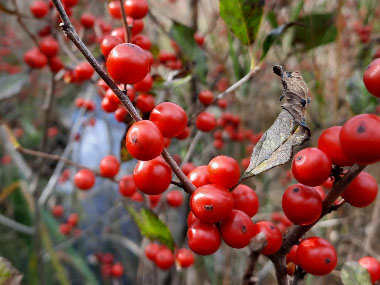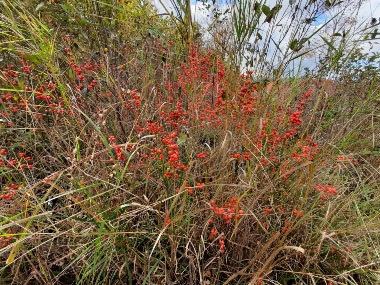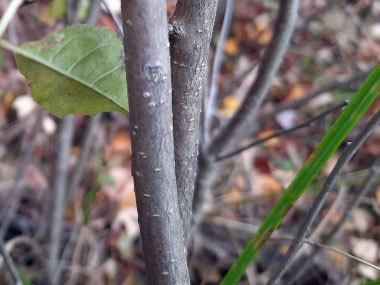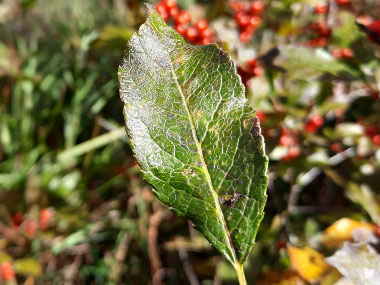





To support our efforts please browse our store (books with medicinal info, etc.).
Winterberry is an upright, deciduous shrub that is somewhat rounded and can be as wide as it is tall. It is a slow-growing, and it often suckers to form large thickets or colonies. The berries are enjoyed by over 40 species of birds, including songbirds, winter waterfowl, and game birds. The shrub is a favorite of small mammals who enjoy the berries and seeds. Berries are quite showy and will persist throughout the winter (hence the common name) and often into early spring. This shrub is in the holly family of shrubs (Aquifoliaceae). Winterberry is commonly referred to as black alder or winterberry holly.
Trunk/Bark
The bark is smooth, thin and grey but may become rough with age.
Branches/Twigs
Twigs are thin, grey but can become brown in winter.
Height
Winterberry typically grows anywhere from 2 to 4.5 metres (6 to 15’) tall depending on the age and location.
Leaves/Needles
Being a deciduous shrub it loses its leaves in the autumn. Dark green leaves grow alternate, are elliptic to obovate, toothed, and measure 5 to 7cm (2-3”) long. Fall color is usually negligible, but in sometimes the leaves may turn to attractive shades of maroon. There is one leaf per node along the stem.
Flowers
This shrub produces clusters of small white flowers that bloom June to July. Relatively inconspicuous greenish-white flowers appear in the leaf axils in late spring. Flowers, if properly pollinated, give way to bright red berries in late summer to fall. The male winterberry produces staminate flowers (with stamens) while the female produces pistillate flowers (with pistils). Only pistillate flowers produce fruit.
Fruit
Winterberry produces large quantities of bright red berries that remain on the shrub through the autumn and into the winter. Berries measure about 0.6cm (1/4”) in diameter.
Habitat
Although this has become a cultivated shrub, winterberry grows wild in acidic soils in forested wetlands or along edges of ponds, lakes and marshes. Winterberry thrives in wet areas, particularly in swamps and marshes. Its native range is in central and eastern North America.
Edible Parts
Historically the leaves were used (dried) to make tea. Drink only on occasion, not regularly.
Other Name
Winterberry Holly.
Recipes
Winter Survival Food Handbook

PDF Plant Magazines
Types of Wild Food
Geographic Zones Seasons
Disclaimer
EdibleWildFood.com is informational in nature. While we strive to be 100% accurate, it is solely up to the reader to ensure proper plant identification. Some wild plants are poisonous or can have serious adverse health effects.
We are not health professionals, medical doctors, nor are we nutritionists. It is up to the reader to verify nutritional information and health benefits with qualified professionals for all edible plants listed in this web site. Please click here for more information.
Why Edible Wild Food?
- Food costs are rising
- Free, wild food is readily abundant
- Wild food adds nutrition to your diet
- Wild food can help treat various medical conditions





